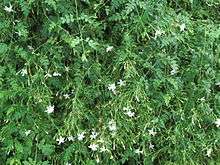Jasminum grandiflorum
Jasminum grandiflorum, also known variously as the Spanish jasmine, Royal jasmine, Catalan jasmine, among others,[2] is a species of jasmine native to South Asia, the Arabian peninsula, East and Northeast Africa and the Yunnan and Sichuan regions of China. The species is widely cultivated and is reportedly naturalized in Guinea, the Maldive Islands, Mauritius, Réunion, Java, the Cook Islands, Chiapas, Central America, and the Caribbean.[1]
| Jasminum grandiflorum | |
|---|---|
| Scientific classification | |
| Kingdom: | Plantae |
| Clade: | Tracheophytes |
| Clade: | Angiosperms |
| Clade: | Eudicots |
| Clade: | Asterids |
| Order: | Lamiales |
| Family: | Oleaceae |
| Genus: | Jasminum |
| Species: | J. grandiflorum |
| Binomial name | |
| Jasminum grandiflorum | |
Description
It is a scrambling deciduous shrub growing to 2–4 m tall. The leaves are opposite, 5–12 cm long, pinnate with 5–11 leaflets. The flowers are produced in open cymes, the individual flowers are white having corolla with a basal tube 13–25 mm long and five lobes 13–22 mm long.[3][4] The flower's fragrance is unique and sweet.
Subspecies
Two subspecies are recognized:[1]
Uses
In India, its leaves are widely used as an Ayurvedic herbal medicine and its flowers are used to adorn the coiffure of women. In Pakistan, it grows wild in the Salt Range and Rawalpindi District at 500–1500 m altitude.[3] It is closely related to, and sometimes treated as merely a form of, Jasminum officinale.[7] The plant is known as "saman pichcha" or "pichcha" in Sri Lanka. Buddhist and Hindu temples use these flowers in abundance.
It is widely cultivated as an ornamental plant in warm temperate and subtropical regions.
By method of solvent extraction the Jasmine flowers are converted into Jasmine Concrete and Jasmine Oleoresin (sold as Jasmine Absolute). Both products have a huge demand in the fragrance industry.
Methyl jasmonate isolated from the jasmine oil of Jasinum gradiflorum led to the discovery of the molecular structure of the jasmonate plant hormones.[8]

Etymology
'Jasminum' is a Latinized form of the Arabic word, 'yasemin' for sweetly scented plants.[9]
References
- "Jasminum grandiflorum". Plants of the World Online. Royal Botanic Gardens, Kew. Retrieved 24 May 2020.
- "Jasminum grandiflorum". Germplasm Resources Information Network (GRIN). Agricultural Research Service (ARS), United States Department of Agriculture (USDA). Retrieved 10 January 2018.
- Flora of Pakistan: Jasminum grandiflorum
- Flora of China v 15 p 313: Jasminum grandiflorum
- Green, Peter Shaw. 1986. Kew Bulletin 41: 414.
- Fresenius, Johann Baptist Georg Wolfgang. 1837. Museum Senckenbergianum. Abhandlungen aus dem Gebiete der Beschreibenden Naturforschenden Gesellschaft in Frankfurt am Main 2: 16.
- Huxley, A., ed. (1992). New RHS Dictionary of Gardening. Macmillan ISBN 0-333-47494-5.
- Demole E (1962). "Isolement et détermination de la structure du jasmonate de méthyle, constituant odorant caractéristique de l'essence de jasminIsolement et détermination de la structure du jasmonate de méthyle, constituant odorant caractéristique de l'essence de jasmin". Helv Chim Acta. 45: 675–85. doi:10.1002/hlca.19620450233.
- Gledhill, David (2008). "The Names of Plants". Cambridge University Press. ISBN 9780521866453 (hardback), ISBN 9780521685535 (paperback). pp 220